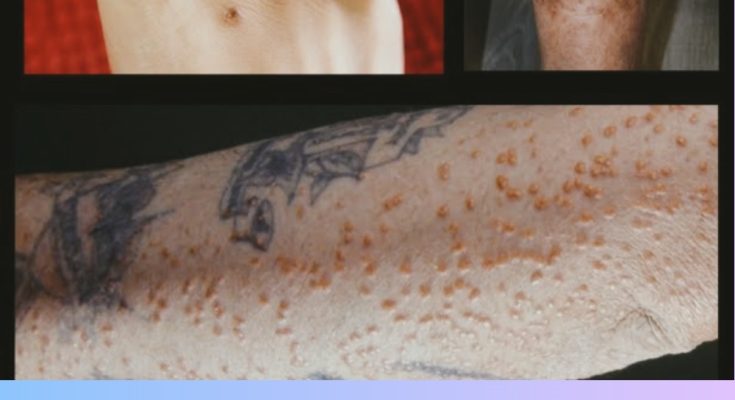Diabetes can significantly impact various organ systems, and the skin is often one of the first to show signs. High blood sugar levels, impaired circulation, nerve damage, and a weakened immune system all contribute to these skin conditions.
Here are 12 skin conditions commonly associated with diabetes:
- Acanthosis Nigricans: This condition causes dark, velvety patches of skin, most often in the folds of the body such as the neck, armpits, and groin. It’s a strong indicator of insulin resistance, often seen in individuals with prediabetes or type 2 diabetes.
- Diabetic Dermopathy (Shin Spots): These are small, round or oval, light brown or reddish patches, typically found on the shins. They may look like age spots or scars and are harmless, often not causing any symptoms. They are thought to be caused by changes in small blood vessels.
- Necrobiosis Lipoidica Diabeticorum (NLD): This is a rarer condition that starts as a dull, red raised area and progresses to a shiny, yellowish-brown patch with a waxy or atrophic (thinned) center and a prominent violet border. Blood vessels under the skin may be visible. NLD often occurs on the shins and can be itchy, painful, and sometimes ulcerate.
- Diabetic Bullae (Diabetic Blisters/Bullosis Diabeticorum): Rarely, people with diabetes can develop painless blisters that resemble burn blisters. They typically appear on the backs of fingers, hands, toes, feet, and sometimes on legs or forearms. They usually heal on their own within a few weeks without scarring and are often associated with diabetic neuropathy.
- Eruptive Xanthomatosis: This condition appears as firm, yellow, pea-like bumps with a red halo, often itchy. They typically occur on the backs of hands, feet, arms, legs, and buttocks. Eruptive xanthomatosis is a sign of very high triglyceride levels, often seen in poorly controlled diabetes. The bumps usually disappear once blood sugar and fat levels are controlled.
- Bacterial Infections: People with diabetes are more susceptible to bacterial infections due to a compromised immune system and higher sugar levels in tissues. Common bacterial skin infections include:
- Boils: Painful, pus-filled lumps.
- Folliculitis: Infection of hair follicles.
- Styes: Infections of glands in the eyelid.
- Carbuncles: Deeper, more widespread infections of the skin and underlying tissue.
- Erysipelas and Cellulitis: Spreading skin infections that can be serious.
- Fungal Infections: Fungi thrive on sugar, making people with diabetes more prone to these infections, especially those caused by Candida albicans (yeast).
- Thrush (Oral Candidiasis): White patches in the mouth.
- Vaginal Yeast Infections: More common and often recurrent in women with diabetes.
- Athlete’s Foot (Tinea Pedis): Fungal infection of the feet.
- Jock Itch (Tinea Cruris): Fungal infection in the groin area.
- Ringworm (Tinea Corporis): A circular fungal rash.
- Intertrigo: Rashes that occur in skin folds (armpits, under breasts, groin) due to yeast or fungal overgrowth.
- Diabetic Neuropathic Ulcers: Due to nerve damage (neuropathy), particularly in the feet, people with diabetes may lose sensation. This can lead to unnoticeable injuries that, combined with poor circulation and a weakened immune system, can develop into chronic, non-healing ulcers. These are a major cause of amputations in diabetes.
- Scleredema Diabeticorum: A rare condition where the skin becomes thick, hard, and waxy, typically on the back of the neck, shoulders, upper back, and sometimes face. It can make movements difficult and is usually seen in long-standing, poorly controlled type 2 diabetes.
- Generalized Itching (Pruritus): Diabetes can cause widespread itchiness, often due to dry skin, poor circulation, or sometimes undetected fungal infections.
- Granuloma Annulare: This condition causes raised, red, or skin-colored bumps that form a ring pattern on the skin. While it can occur in anyone, it is more commonly seen in people with diabetes, especially the “disseminated” form where lesions appear all over the body.
- Digital Sclerosis (Waxy Skin, Stiff Joints): People with diabetes may develop thick, tight, waxy skin on the backs of their hands and fingers, making it difficult to move their joints. This can also affect the toes and forehead.
Key takeaway for all these conditions:
Maintaining good blood sugar control is the most important step in preventing and managing these skin conditions. Regular skin checks, especially of the feet, and prompt medical attention for any new or worsening skin issues are also crucial.

